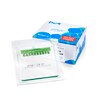MABE351 Sigma-AldrichAnti-acetyl-Histone H3 (Lys14) Antibody, clone 13HH3-1A5
Anti-acetyl-Histone H3 (Lys14) Antibody, clone 13HH3-1A5 is a mouse monoclonal antibody for detection of acetyl-Histone H3 (Lys14) also known as Histone H3.1t, H3/t, H3t, H3/g & has been validated in WB, IP, ICC.
More>> Anti-acetyl-Histone H3 (Lys14) Antibody, clone 13HH3-1A5 is a mouse monoclonal antibody for detection of acetyl-Histone H3 (Lys14) also known as Histone H3.1t, H3/t, H3t, H3/g & has been validated in WB, IP, ICC. Less<<Recommended Products
Áttekintés
| Replacement Information |
|---|
Kulcsspecifikációk táblázata
| Species Reactivity | Key Applications | Host | Format | Antibody Type |
|---|---|---|---|---|
| H, M | WB, IP, ICC, ChIP-seq, ChIP | M | Ascites | Monoclonal Antibody |
| References |
|---|
| Product Information | |
|---|---|
| Format | Ascites |
| Control |
|
| Presentation | Mouse monoclonal IgG1 in ascites containing 0.05% sodium azide. |
| Quality Level | MQ100 |
| Physicochemical Information |
|---|
| Dimensions |
|---|
| Materials Information |
|---|
| Toxicological Information |
|---|
| Safety Information according to GHS |
|---|
| Safety Information |
|---|
| Packaging Information | |
|---|---|
| Material Size | 100 µL |
| Transport Information |
|---|
| Supplemental Information |
|---|
| Specifications |
|---|
| Global Trade Item Number | |
|---|---|
| Katalógusszám | GTIN |
| MABE351 | 04053252697760 |
Documentation
Anti-acetyl-Histone H3 (Lys14) Antibody, clone 13HH3-1A5 MSDS
| Title |
|---|
Anti-acetyl-Histone H3 (Lys14) Antibody, clone 13HH3-1A5 Certificates of Analysis
References
| Reference overview | Application | Species | Pub Med ID |
|---|---|---|---|
| H3K9 and H3K14 acetylation co-occur at many gene regulatory elements, while H3K14ac marks a subset of inactive inducible promoters in mouse embryonic stem cells. Karmodiya, Krishanpal, et al. BMC Genomics, 13: 424 (2012) 2011 Kivonat megmutatása | Chromatin Immunoprecipitation (ChIP) | Mouse | 22920947
 |
















